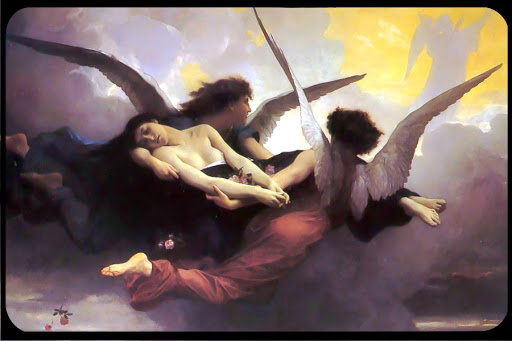It is now officially November, and while Hallowmass has come to pass, the Church encourages her faithful to carry on in their task of praying for the Holy Souls in Purgatory. Moreover, until the 8th of this month, the plenary indulgence applicable to the Faithful Departed upon making a pious visit to a cemetery remains in effect (more on that at CatholicCulture.org). As such, the time is right for a revisiting of the Requiem Mass, which began with last week’s close-up look at the Mozart Requiem – namely, its meditation on Death, Judgment, Hell, and Heaven (the Four Last Things). But whereas the segments of the Mozart Requiem that we covered last week were mostly a reflection on the first three of these, today’s exploration will focus exclusively on Heaven – particularly as it was depicted in music by the French composer, Gabriel Fauré (1845-1924).
But first, a brief primer on the artist himself. Fauré lived during a transitionary period in history, from the end of the Romantic era to the beginning of modernism in the 20th century. As such, his music – especially in the latter part of his career – exhibited both the emotional stirrings and vivid scenes of Romanticism by means of the unconventional harmonies and compositional techniques of modernism. The result, at least in the case of his Requiem (written from 1887-1890, and rewritten in its present form in 1900), is an ethereal masterpiece abounding with rich textures and awe-inspiring portrayals of the supernatural.
There are a few differences between the Mozart and Fauré requiems, structurally speaking. While the former includes the “Dies Iræ” sequence, the latter forgoes it altogether, and instead includes the “Pie Jesu,” “Libera me,” and “In paradisum.” The last of these is still used in funeral Masses today, even after the liturgical reforms of Vatican II, and is proclaimed during the Commendation of the Body in the final moments of the Mass. The prayer is a serene depiction of the welcoming into the Kingdom of Heaven – the heavenly Jerusalem, which is the inheritance of those who die in the grace of God.
In paradisum deducant te Angeli;
in tuo adventu suscipiant te martyres
et perducant te in civitatem sanctam Jerusalem.
Chorus angelorum te suscipiat,
et cum Lazaro, quondam paupere,
æternam habeas requiem.
~ ~ ~
May the angels lead you into paradise;
upon your arrival, may the martyrs receive you
and lead you to the holy city of Jerusalem.
May the ranks of angels receive you,
and with Lazarus, once a poor man,
may you have eternal rest.
Fauré’s exposition of this moving prayer begins with a minimalistic ostinato played by the organ and orchestra. This musical mantra, which sets the overall texture of the instrumental components in this movement, grows together with the piece as it approaches its climax, but it is initially kept restrained and repetitive. It is a technique by which Fauré helps to clear the mind and give it a sense of peace; in essence, it is similar to the experience of immersing oneself in the prayers of the rosary, in which the repetition of prayers creates a state in which we are free to clear the mind and soothe the soul.
The subtlety of the instrumental accompaniment permits the sweet simplicity of the sung melody to permeate through the air. It transports us to a place beyond this world that is yet unknown, all while being reassured that there, we shall find a tranquil ecstasy, and peaceful fulfillment at last. The voices, traditionally those of boy sopranos, sing a single melody against the orchestral ostinato in a manner reminiscent of Gregorian chant. Indeed, these voices – innocent and pure – are those of the angels, who have come to take a weary soul to its final resting place (“In paradisum … suscipiant te Martyres”).
As the celestial band approaches the gates of Heaven – the New Jerusalem – the music begins to swell in joyful anticipation of that first glimpse of Paradise. At the singing of “Jerusalem,” the lower voices join the sopranos in a gradual crescendo, which is further reinforced by the chromatic blossoming of the harmonies, until the phrase reaches its glorious climax. It is here that the gates have been fully opened, the luminous glory of Jerusalem bathing everything in its celestial light (“et perducant te in civitatem sanctam Jerusalem”).
The angelic voices return at the singing of “Chorus angelorum” in a manner that mirrors the opening of the movement, their prayer slowly climbing the scale until reaching another climax (albeit a shorter one) at “æternam” – the promise of an everlasting life that knows no end; a life forever transformed, like that of Lazarus the beggar, who now dwells in the magnificence of God. The choir returns at “requiem,” reminding us that it is the communal duty of the living to pray for dead. And so they do, singing “æternam habeas requiem” in a final act of farewell. The music fades away, vanishing just like the soul of the departed one as the gates of Heaven close behind him. And in the midst of this silence, we realize that we have come to behold that great peace which the world cannot give, for it is found only in the presence of the Lord.
Requiem æternam dona eis, Domine,
et lux perpetua luceat eis.
Requiescant in pace. Amen.

